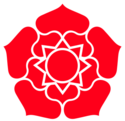Chandan Socialist Birlik Front
This article is incomplete because it is pending further input from participants, or it is a work-in-progress by one author. Please comment on this article's talk page to share your input, comments and questions. Note: To contribute to this article, you may need to seek help from the author(s) of this page. |
Chandan Socialist Birlik Front 𑐀𑐬𑐎𑐶𑐣𑐵𑐮𑐶 𑐲𑐵𑐩𑐵𑐖𑐮𑐶𑐎 𑐧𑐶𑐬𑐮𑐶𑐎 𑐴𑑁𑐮𑐮𑑀𑐴 Arkinali Samajlik Birlik Holboh | |
|---|---|
 | |
| Abbreviation | ASBH |
| Chairman | Hotamjon Khan |
| President | Pernille Urksal |
| Founded | 15 November 1949 (as party) 11 February 2001 (as alliance) |
| Preceded by | Chandan National Front |
| Headquarters | 14 North, 3rd Capitol District, Taglikend |
| Newspaper | National Review |
| Youth wing | ASBH Youth League |
| Women's wing | ASBH Women's League |
| Veteran's League | ASBH Veterans League |
| Armed wing | People's Liberation Army |
| Labour wing | National Labour Union |
| Membership | 2 million (2020) |
| Ideology | Pro-Chandan government Birlikism |
| Political position | Big tent Factions: Centre-left to far-left |
| Colors | Red |
| Supreme Council | 15 / 15
|
| National Assembly | 329 / 381
|
| Seats in local assemblies | 3,336 / 3,810
|
The Chandan Socialist Birlik Front (Chandan: 𑐀𑐬𑐎𑐶𑐣𑐵𑐮𑐶 𑐲𑐵𑐩𑐵𑐖𑐮𑐶𑐎 𑐧𑐶𑐬𑐮𑐶𑐎 𑐴𑑁𑐮𑐮𑑀𑐴, Arkinali Samajlik Birlik Holboh), commonly known as the ASBH, is a political alliance of political parties in Chanda that supports the Birlikist ideology and its related sub-ideologies.
The Front was officially founded during the Chandan National Revolution in order to provide a movement for the proponents of Birlikist principles. The Declaration of the Republic, Chanda's founding constitution, states that the country shall "stay true to the principles of Birlikism as written by the Founders through the governance of a united front", thereby constitutionalizing Birlikism as the national ideology. Since the founding of the Republic, the role of a "united front" has been filled by the Front. While Chanda is technically not a one-party state, the parties of the Front must accept the "guiding role" of Birlikism in order to be a member of the Front. From the founding of the country in 1951 to the 1970s, the Front had near absolute power over the government as a unified political party.
However beginning in the 1970, power began to fall from the leadership to its party members who were becoming increasingly independent and ideologically diverse. As a result, the growing power of the party members led to the diversification of the Front into various political factions and informal political organizations. Although all factions proclaim their commitment to Birlikism, in reality they practice differing Birlikist inspired ideologies. Political experts consider the Front as a "guiding" political institution that allows some differing political opinions while ensuring that its constituent factions remain committed to the ideological foundations of the country.
Front members are often members of member organisations, which are groups of delegates who meet to pursue common objectives. Some types of organizations are single issue organizations centered around addressing a single issue, or geographical organizations which group together delegates from a certain region, or ideological organizations which group together ideologically aligned delegates. Since members are not limited to membership to a single organization, membership is fluid and organizations can emerge and disband in a few years. However as membership is not restricted to one group, it is common for delegates to be a part of two or more organisations, mostly with the aim of promoting cooperation.
Ideological organizations are the largest and most prominent, which divide the Front into political factions. Today the Front is divided into four broad factions,the Reformists, the Chandan Left, the Republicans, and the Kharists. The Reformists are the most radical; they primarily seek constitutional reform and the deepening ties with Senria. The Left are focused on socialist leaning economic reform and have a pragmatic approach to foreign policy. The Republicans are staunch conservatives and supporters of the status quo; some even seek to roll back constitutional and economic reforms. Kharists consist of the political supporters of the People's Liberation Army. Since the 2019 general election the Front is led by a coalition of moderate Leftists and Reformists, led by President Pernille Urksal and Vice-President Gulshara Khan who favors market socialism, moderate internationalism, and constitutional reformism.
History
Background
Establishment
Nationalist Years
Reform Era
Reformation of Chanda
Ideology
Constituent parties
Organisation
Electoral history
| Election | Seats | +/– | Position |
|---|---|---|---|
| 1950 | 250 / 250
|
||
| 1951 | 285 / 285
|
||
| 1959 | 331 / 331
|
||
| 1963 | 331 / 331
|
||
| 1967 | 331 / 331
|
||
| 1971 | 381 / 381
|
||
| 1975 | 381 / 381
|
||
| 1983 | 381 / 381
|
||
| 1987 | 381 / 381
|
||
| 1991 | 381 / 381
|
||
| 1995 | 381 / 381
|
||
| 1999 | 366 / 381
|
||
| 2003 | 345 / 381
|
||
| 2007 | 340 / 381
|
||
| 2011 | 351 / 381
|
||
| 2015 | 344 / 381
|
||
| 2019 | 329 / 381
|